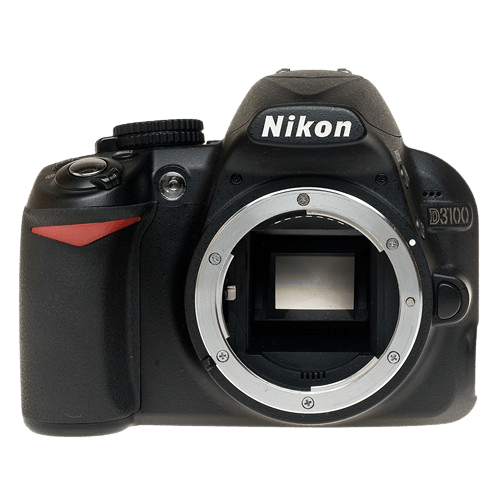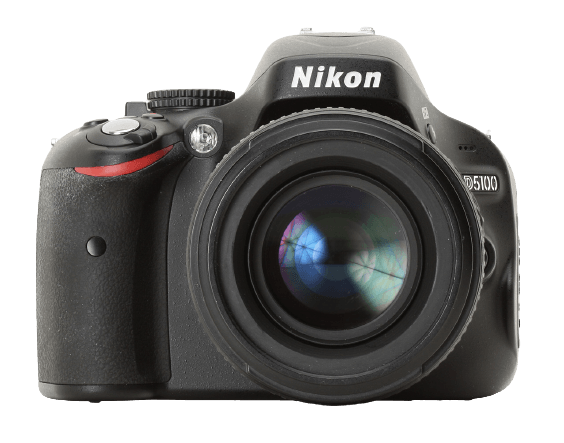Nikon D3100 vs D5100 Comparison
Nikon D3100

Nikon D5100

The Nikon D5100 emerges as the winner with a score of 49/100, while the Nikon D3100 trails behind at 41/100. Both cameras share common specifications, such as being DSLR cameras and having similar dimensions, with the D5100 at 128 x 97 x 79mm and the D3100 at 124 x 96 x 75mm.
The D5100 takes the lead due to its better performance and features, justifying its higher launch price of $799 compared to the D3100’s $699. However, the D3100 has the advantage of being lighter, weighing 505g compared to the D5100’s 560g.
Taking all factors into consideration, the Nikon D5100 proves to be a superior camera, while the Nikon D3100 may appeal to those looking for a lighter and more affordable option.
Nikon D3100 vs D5100 Overview and Optics
The Nikon D5100 outperforms the Nikon D3100 in optics, with a score of 52/100 compared to the D3100’s 41/100. This 11-point difference highlights the superior optical quality of the D5100.
Both cameras share some common specifications, including the CMOS sensor type, Expeed 2 processor, APS-C sensor size, Nikon F DX lens mount, and lack of image stabilization. These shared features provide a solid foundation for both cameras’ performance.
The D5100 surpasses the D3100 in several areas. It boasts a higher megapixel count of 16.2, compared to the D3100’s 14.8, resulting in more detailed and higher resolution images. Additionally, the D5100 has a faster shooting speed of 4 frames per second (fps), while the D3100 has a shooting speed of 3 fps. This advantage allows the D5100 to capture fast-moving subjects more effectively. Furthermore, the D5100 has a higher DXOMARK score of 80 for its sensor, compared to the D3100’s score of 67, indicating better overall image quality.
The D3100, however, does not offer any significant advantages over the D5100 in terms of optics. Its lower score and specifications make it a less attractive option for those seeking superior optical performance.
Considering the advantages of the Nikon D5100, it is clear that this camera offers better optical performance than the Nikon D3100. With a higher megapixel count, faster shooting speed, and superior sensor quality, the D5100 is the better choice for photographers seeking enhanced image quality and performance. On the other hand, the D3100 may still be a viable option for beginners or those on a tighter budget, but with the understanding that it does not match the D5100 in terms of optics.
Nikon D3100 vs D5100 Video Performance
Moving on to the video capabilities of the Nikon D3100 and Nikon D5100, it is important to note that neither of these cameras have video functionality. Therefore, there is no difference between them in this aspect. The lack of video features does not influence their scores, as the scores are determined by their overall performance and capabilities.
Nikon D3100 vs D5100 Features and Benefits
The Nikon D5100 emerges as the winner in the features category with a score of 41/100, while the Nikon D3100 scores 36/100. Both cameras share several specifications, such as a 3-inch screen size, no touchscreen, no GPS, no WIFI, and no Bluetooth capabilities.
The D5100 outperforms the D3100 in screen resolution and screen functionality. It boasts a screen resolution of 921,000 dots, which is significantly higher than the D3100’s 230,000 dots. This difference allows the D5100 to display images with greater clarity and sharpness. Additionally, the D5100 features a flip screen, providing more flexibility for capturing images from various angles and aiding in self-portraits or vlogging.
On the other hand, the D3100 does not surpass the D5100 in any particular feature. However, it is worth noting that its lower score does not mean it is a poor camera. The D3100 still offers a solid performance and meets the needs of beginner photographers or those on a tighter budget.
After examining the features of both cameras, it is evident that the Nikon D5100 holds an advantage over the Nikon D3100, mainly due to its higher screen resolution and flip screen. This makes the D5100 more suitable for photographers seeking better image preview quality and increased flexibility in shooting angles. However, the Nikon D3100 remains a viable option for those who prioritize affordability and are satisfied with its offered features.
Nikon D3100 vs D5100 Storage and Battery
The Nikon D3100 wins in the storage and battery category with a score of 53/100, while the Nikon D5100 scores slightly lower at 51/100. Both cameras share some common specifications in this aspect. They each have one memory card slot and accept SD, SDHC, and SDXC memory cards. Neither camera offers USB charging, and both use the same EN-EL14 battery type.
The Nikon D3100 outperforms the D5100 in battery life, offering 4500 shots compared to the D5100’s 2200 shots. This significant difference provides the D3100 with a clear advantage for extended photography sessions without needing to change batteries.
On the other hand, the Nikon D5100 does not have any notable advantages over the D3100 in terms of storage and battery. Both cameras share similar storage options, and the D5100’s battery life is inferior to the D3100.
Taking into account the longer battery life of the Nikon D3100, it proves to be the superior choice in the storage and battery category. The Nikon D5100, although comparable in storage options, falls short in battery performance, making the D3100 a better option for photographers who require longer shooting times.
Nikon D3100 vs D5100 – Our Verdict
Are you still undecided about which camera is right for you? Have a look at these popular comparisons that feature the Nikon D3100 or the Nikon D5100:

